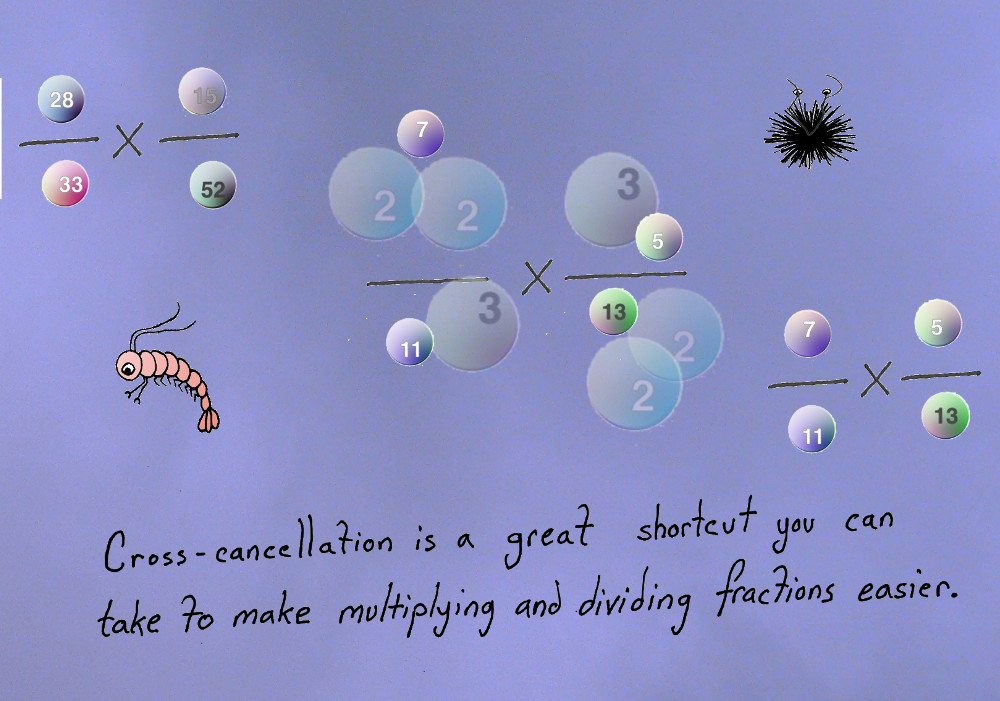Cross-cancellation is a shortcut that you can use to make multiplying fractions easier. Sometimes you have to simplify fractions after doing arithmetic with them. Cross-cancellation is a simplification that can be done before. That’s great,because simplifying before means when you do multiply, you’ll have smaller numbers, and smaller numbers are easier to work with.
Did you catch that? Cross-cancellation makes fractions easier.
But whatoperation canyou use cross-cancellation on? Multiplication of fractions.
In mathematics, we use the word operation for something basic that you do to a number. The most common examples of operations are adding, subtracting, multiplying, and dividing(there’s others, but let’s not get into that right now).
Cross-cancellation and Division
In addition to multiplication, cross-cancellation can be used to make math easier when fractions are divided. That’s because you can always convert a fraction division problem to a fraction multiplication problem. Just takethe reciprocal of the divisor. Taking the reciprocal of a fraction just means swapping the numerator and the denominator (put the top on the bottom, and the bottom on the top). The divisor is the number that you are dividing by.
How do you cross-cancel?
You can cross-cancel systematically, butthere’salso some shortcuts. Here’s the systematicway to cross-cancel:
- If a division problem is being converted into multiplication, first rewrite it converting the divisor into its reciprocal.
- Find the prime factorization of both the numerator and denominator of both fractions.
- If either factor was not in simplest form,perform the simplification now.
- Cancelany factors found both in a numerator and the oppositedenominator. In fact, it’s because these factors are located diagonally from each other, thatwe call itcross-cancellation. If multiple copies of any factor are present, deal with them by canceling only as many copies as are present in the opposite location (the same as when simplifying fractions).
- Repeat the previous stepon the other diagonal.
- Multiply all factors on the top of both fractions to form the numerator of the answer, and multiply all factors on the bottom of both fractions to form the denominator of the answer.
Do you always have to do all that? No, not always. Did you notice where weused the word systematic to describe that step-by-step way of doing cross-cancellation?Some people probably ignored that word, andsome other people might have wondered what it meant, and had a sinking feeling that we’re using fancy words, and things might soon stop making sense. Please don’t worry. What we meant by systematic was that anyone who can follow those steps will get the right answer at the end. When you’re familiar with the process, you can usually combine or skip steps, use alternative techniques, or take short cuts.
Cross-cancellation with the GCF Shortcut
You can save workif the numbers are relatively small andyou can see some common factors. In such a case you don’t have to find the complete prime factorization. Instead, we usually cross out numbers across a diagonal and write replacement numbers next to them with the Greatest Common Factors removed. Here’s an example of what this techniquelooks like.
Cross-cancellation and Fraction Simplification
Cross-cancellation is really a special version of simplifying fractions. You can only take advantage of it when multiplying or dividing fractions. It’s worth practicing simplifying fractionsfirst in order to get a larger perspective, and to get an appreciation for how it’s useful. In fact, theadvantage ofcross-cancellation overmultiplying and then simplifying is thatbefore the numbers are multiplied they are smaller and easier to work with. You get the same answer if you multiply first, and then simplify, but it can be a lot more work. Cross-cancellation isjust a shortcut, but a good one.
How do you Get Good at Cross-cancelling?
Getting good at most things takes practice. We have created a game, Bubbly Primes, with the purpose of giving students lots of practice factoringso they gain the ability to see common factors like in the GCF technique. It’s a fun wayto cultivateskills that traditionally come fromspending lots of time on worksheets and quizzes. We encourage you to spend some time playing the game.
What’s the difference between cross-cancellation and cross-multiplication?
Sometimes students confuse cross-cancellation with cross-multiplication. It’s easy to do, because the names are similar, both have to do with fractions, and furthermore, both have to do with multiplication. However:
- Usecross multiplicationto algebraically manipulate an equality involving fractions on either side of the equal sign, usually to solve for a variable.
- Use Cross-cancellationas a simplification technique when two fractions are being multiplied.
Usually the two techniques are forentirely different kinds of problems. Here’s an example of each.

Next Topic: Kinds of Numbers


